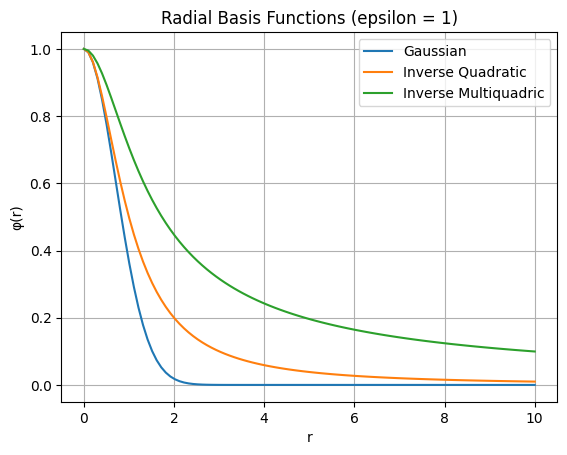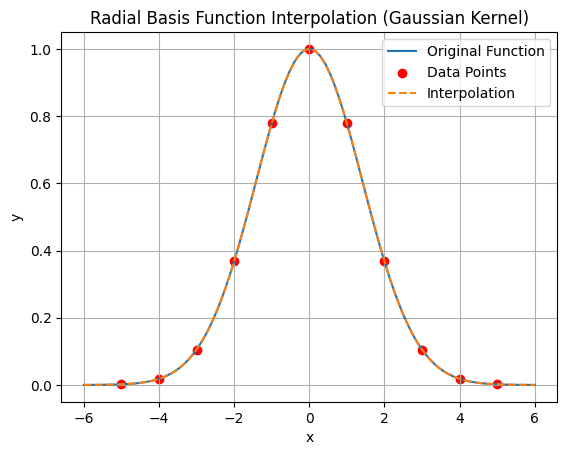Radial Basis Functions#
Radial basis functions are an n-dimensional interpolation technique that doesn’t rely on polynomials. Rather, we define a radial basis function, called a kernel, applied to each data point:
Commonly, we say \(\varphi_i(x=x_i)\equiv 1\).
The kernel only depends on the Euclidian distance between the associated data point, \(x_i\) and the evaluation point \(x\) (and are therefore radial).
The interpolation function \(y(x)\) is the weighted sum of the \(N\) kernels:
To determine the weights \(w_i\), we use the data points we have. Consider the \(i\)’th datapoints,
and applied to all N data points generates a linear system:
which we know how to solve!
Kernels are defined with \(r = \| x-x_i\|\) and a tuning parameter \(\epsilon\). Some common simple kernels are:
Kernel |
Formula |
|---|---|
Gaussian |
\(e^{-\epsilon^2 r^2}\) |
Inverse quadratic |
\(\frac{1}{1+[\epsilon r ]^2}\) |
Inverse multiquadric |
\(\frac{1}{\sqrt{1+[\epsilon r ]^2}}\) |
Determination of optimal \(\epsilon\) is a nuanced question, but a good rule of thumb is to use the average distance between samples.
\(\epsilon = \frac{1}{avg \|x_i-x_j\|}\)
We will see that its choice has a large effect on the condition number of the matrix, and therefore the numerical robustness!
Let’s see the kernels:
import numpy as np
import matplotlib.pyplot as plt
# Define the radial basis functions
def gaussian(r, epsilon):
return np.exp(-(epsilon * r)**2)
def inverse_quadratic(r, epsilon):
return 1 / (1 + (epsilon * r)**2)
def inverse_multiquadric(r, epsilon):
return 1 / np.sqrt(1 + (epsilon * r)**2)
epsilon = 1
# Create a range of r values
r_values = np.linspace(0, 10, 100)
# Calculate the function values for each kernel
gaussian_values = gaussian(r_values, epsilon)
inverse_quadratic_values = inverse_quadratic(r_values, epsilon)
inverse_multiquadric_values = inverse_multiquadric(r_values, epsilon)
# Plot the radial basis functions
plt.plot(r_values, gaussian_values, label='Gaussian')
plt.plot(r_values, inverse_quadratic_values, label='Inverse Quadratic')
plt.plot(r_values, inverse_multiquadric_values, label='Inverse Multiquadric')
plt.xlabel('r')
plt.ylabel('φ(r)')
plt.title('Radial Basis Functions (epsilon = 1)')
plt.legend()
plt.grid(True)
plt.show()

For these kernels, the influence of a data point diminishes the further from them you get.
In general, \(\varphi_i(r=0)\) is not necessarily \(1\), and \(\varphi(r \rightarrow \infty) \ne 0\), but this requires one more key factor to implement robustly.
Example - Our Toy problem from last lecture (Gaussian sampled at 10 points, equally spaced)#
import numpy as np
import matplotlib.pyplot as plt
# Define the function
def f(x):
return np.exp(-(x/2)**2)
def gaussian(r, epsilon):
return np.exp(-(epsilon * r)**2)
# Create x values for plotting
x_toy = np.linspace(-6, 6, 100)
y_toy = f(x_toy)
# Sample 11 times at 1-interval intervals
x_d = np.arange(-5, 6, 1)
y_d = f(x_d)
import matplotlib.pyplot as plt
import numpy as np
# Create a matrix of the radial basis functions
phi_matrix = np.zeros((len(x_d), len(x_d)))
epsilon = 1
for i in range(len(x_d)):
for j in range(len(x_d)):
phi_matrix[i, j] = gaussian(np.abs(x_d[i] - x_d[j]), epsilon)
#~~ How do we solve for w_i?
# Take a look at the matrix!
# #~~ Answer
np.set_printoptions(precision=2, suppress=True)
print(phi_matrix)
weights = np.linalg.solve(phi_matrix, y_d)
# #~~
# Define the interpolation function
def interpolation_function(x, weights, x_d, epsilon):
y = 0
for i in range(len(x_d)):
y += weights[i] * gaussian(np.abs(x - x_d[i]), epsilon)
return y
# Interpolate y_fit
y_fit = [interpolation_function(x, weights, x_d, epsilon) for x in x_toy]
# Plot the results
plt.plot(x_toy, y_toy, label='Original Function')
plt.scatter(x_d, y_d, color='red', label='Data Points')
plt.plot(x_toy, y_fit, label='Interpolation', linestyle='--')
plt.xlabel('x')
plt.ylabel('y')
plt.title('Radial Basis Function Interpolation (Gaussian Kernel)')
plt.legend()
plt.grid(True)
plt.show()
[[1. 0.37 0.02 0. 0. 0. 0. 0. 0. 0. 0. ]
[0.37 1. 0.37 0.02 0. 0. 0. 0. 0. 0. 0. ]
[0.02 0.37 1. 0.37 0.02 0. 0. 0. 0. 0. 0. ]
[0. 0.02 0.37 1. 0.37 0.02 0. 0. 0. 0. 0. ]
[0. 0. 0.02 0.37 1. 0.37 0.02 0. 0. 0. 0. ]
[0. 0. 0. 0.02 0.37 1. 0.37 0.02 0. 0. 0. ]
[0. 0. 0. 0. 0.02 0.37 1. 0.37 0.02 0. 0. ]
[0. 0. 0. 0. 0. 0.02 0.37 1. 0.37 0.02 0. ]
[0. 0. 0. 0. 0. 0. 0.02 0.37 1. 0.37 0.02]
[0. 0. 0. 0. 0. 0. 0. 0.02 0.37 1. 0.37]
[0. 0. 0. 0. 0. 0. 0. 0. 0.02 0.37 1. ]]

Note this is a great result, but it works because the true function tends to zero outside of the data samples.
Example - 2D gaussian#
import numpy as np
import plotly.graph_objects as go
# Define the target function
def f(x, y):
return np.exp(-.5*x**2 - .2*y**2) * np.sin(x) * np.cos(.5*y)
x_grid_vals = np.linspace(-3, 3, 100)
y_grid_vals = np.linspace(-3, 3, 100)
X, Y = np.meshgrid(x_grid_vals, y_grid_vals)
Z_true = f(X, Y)
num_samples = 100
x_samples = np.random.uniform(-3, 3, num_samples)
y_samples = np.random.uniform(-3, 3, num_samples)
z_samples = f(x_samples, y_samples)
def gaussian_rbf(r, epsilon):
return np.exp(-(epsilon * r)**2)
dist_matrix = np.sqrt((x_samples[:, np.newaxis] - x_samples)**2 + (y_samples[:, np.newaxis] - y_samples)**2)
average_distance = np.mean(dist_matrix)
eps = 1 / average_distance
#eps = 1 # In this case, eps =1 gives a better looking answer
print(f"Using epsilon = {eps:.4f}")
phi_matrix = gaussian_rbf(dist_matrix, eps)
print(f'The matrix condition number is, {np.linalg.cond(phi_matrix):.2e}')
weights = np.linalg.solve(phi_matrix, z_samples)
Z_fit = np.zeros_like(X)
for i in range(num_samples):
r = np.sqrt((X - x_samples[i])**2 + (Y - y_samples[i])**2)
Z_fit += weights[i] * gaussian_rbf(r, eps)
surface_true = go.Surface(x=X, y=Y, z=Z_true, colorscale='Blues', showscale=False, name='Original')
surface_fit = go.Surface(x=X, y=Y, z=Z_fit, colorscale='Viridis', showscale=False, name='RBF Fit')
scatter_samples = go.Scatter3d(
x=x_samples, y=y_samples, z=z_samples,
mode='markers', marker=dict(color='red', size=3), name='Samples'
)
# Plot 1: Original Function
fig_original = go.Figure(data=[surface_true, scatter_samples])
fig_original.update_layout(
title='Original Function and Data Samples',
scene=dict(
xaxis_title='x', yaxis_title='y', zaxis_title='z',
zaxis=dict(range=[-.7, .7]),
aspectratio=dict(x=1, y=1, z=0.5)
)
)
fig_original
print("Displaying the original function...")
fig_original.show()
# Plot 2: RBF Interpolation
fig_fit = go.Figure(data=[surface_fit, scatter_samples])
fig_fit.update_layout(
title='RBF Interpolated Fit and Data Samples',
scene=dict(
xaxis_title='x', yaxis_title='y', zaxis_title='z',
zaxis=dict(range=[-.7, .7]),
aspectmode='manual',
aspectratio=dict(x=1, y=1, z=0.5)
)
)
fig_fit
print("Displaying the RBF fitted function...")
fig_fit.show()
Using epsilon = 0.3271
The matrix condition number is, 3.87e+18
Displaying the original function...
Displaying the RBF fitted function...

